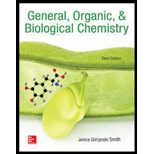
Concept explainers
Using the balanced equation for the combustion of acetylene, answer the following questions.
a. How many moles of
b. How many moles of
c. How many moles of
d. How many moles of
(a)
Interpretation:
Number of moles of
Concept Introduction:
The carbon-containing compound, i.e., acetylene, reacts with oxygen to form water and carbon dioxide. This reaction is known as combustion.
The combustion reaction of acetylene
The formula used to determine the number of moles is:
Answer to Problem 5.87P
The number of moles of
Explanation of Solution
According to the equation:
Moles ratio of
That is if
Then
Hence, the number of moles of
(b)
Interpretation:
Number of moles of
Concept Introduction:
The carbon-containing compound i.e., acetylene, reacts with oxygen to form water and carbon dioxide. This reaction is known as combustion.
The combustion reaction of acetylene
The formula used to determine the number of moles is:
Answer to Problem 5.87P
Number of moles of
Explanation of Solution
According to the equation :
Moles ratio of
i.e., if
Then
Hence, the number of moles of
(c)
Interpretation:
Number of moles of
Concept Introduction:
The carbon-containing compound i.e., acetylene, reacts with oxygen to form water and carbon dioxide. This reaction is known as combustion.
The combustion reaction of acetylene
The formula used to determine the number of moles is:
Answer to Problem 5.87P
Hence, number of moles of
Explanation of Solution
According to the equation:
Moles ratio of
i.e., if
Then
Hence, the number of moles of
(d)
Interpretation:
Number of moles of
Concept Introduction:
The carbon-containing compound, i.e., acetylene, reacts with oxygen to form water and carbon dioxide. This reaction is known as combustion.
The combustion reaction of acetylene
The formula used to determine the number of moles is:
Answer to Problem 5.87P
Hence, number of moles of
Explanation of Solution
According to the equation:
Moles ratio of
i.e., if
Then the number of moles of
Hence, the number of moles of
Want to see more full solutions like this?
Chapter 5 Solutions
EBK GENERAL, ORGANIC, & BIOLOGICAL CHEM
Additional Science Textbook Solutions
College Physics: A Strategic Approach (3rd Edition)
Campbell Essential Biology (7th Edition)
Cosmic Perspective Fundamentals
Fundamentals of Anatomy & Physiology (11th Edition)
Campbell Biology: Concepts & Connections (9th Edition)
Applications and Investigations in Earth Science (9th Edition)
- Describe a sequence of photophysical processes that can be followed by radiation adsorbed by a molecule in the ground state to give rise to phosphorescent emission.arrow_forwardState two similarities between fluorescence and phosphorescence.arrow_forwardState three photophysical processes that can be related to the effects of incident radiation on a molecule in its ground state. Consider that radiation can give rise to fluorescent emission, but not phosphorescent emission.arrow_forward
 Chemistry for Engineering StudentsChemistryISBN:9781337398909Author:Lawrence S. Brown, Tom HolmePublisher:Cengage Learning
Chemistry for Engineering StudentsChemistryISBN:9781337398909Author:Lawrence S. Brown, Tom HolmePublisher:Cengage Learning Chemistry: The Molecular ScienceChemistryISBN:9781285199047Author:John W. Moore, Conrad L. StanitskiPublisher:Cengage Learning
Chemistry: The Molecular ScienceChemistryISBN:9781285199047Author:John W. Moore, Conrad L. StanitskiPublisher:Cengage Learning Chemistry: Principles and PracticeChemistryISBN:9780534420123Author:Daniel L. Reger, Scott R. Goode, David W. Ball, Edward MercerPublisher:Cengage Learning
Chemistry: Principles and PracticeChemistryISBN:9780534420123Author:Daniel L. Reger, Scott R. Goode, David W. Ball, Edward MercerPublisher:Cengage Learning General, Organic, and Biological ChemistryChemistryISBN:9781285853918Author:H. Stephen StokerPublisher:Cengage Learning
General, Organic, and Biological ChemistryChemistryISBN:9781285853918Author:H. Stephen StokerPublisher:Cengage Learning Chemistry & Chemical ReactivityChemistryISBN:9781337399074Author:John C. Kotz, Paul M. Treichel, John Townsend, David TreichelPublisher:Cengage Learning
Chemistry & Chemical ReactivityChemistryISBN:9781337399074Author:John C. Kotz, Paul M. Treichel, John Townsend, David TreichelPublisher:Cengage Learning World of ChemistryChemistryISBN:9780618562763Author:Steven S. ZumdahlPublisher:Houghton Mifflin College Div
World of ChemistryChemistryISBN:9780618562763Author:Steven S. ZumdahlPublisher:Houghton Mifflin College Div





